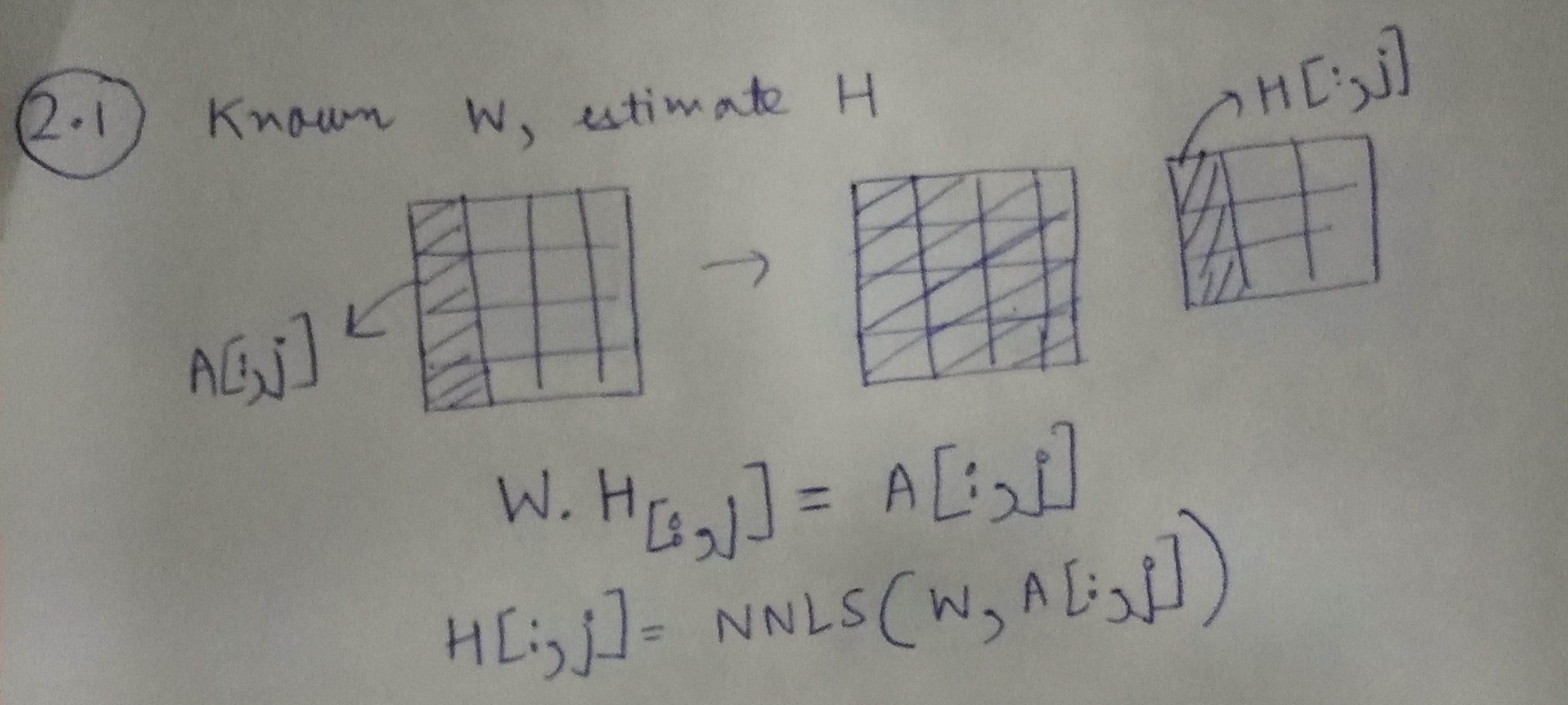Scipy has a method to solve non-negative least squares problem (NNLS). In this answer, I am reproducing my blogpost on using scipy's NNLS for non-negative matrix factorisation. You may also be interested in my other blog posts that use autograd, Tensorflow and CVXPY for NNMF.
Goal: Our goal is given a matrix A, decompose it into two non-negative factors, as follows:
A (M×N) ≈ W (M×K) × H (K×N), such that W (M×K) ≥ 0 and H (K×N) ≥ 0
![Goal]()
Overview
Our solution consists of two steps. First, we fix W and learn H, given A. Next, we fix H and learn W, given A. We repeat this procedure iteratively. Fixing one variable and learning the other (in this setting) is popularly known as alternating least squares, as the problem is reduced to a least squares problem. However, an important thing to note is that since we want to constraint W and H to be non-negative, we us NNLS instead of least squares.
Step 1: Learning H, given A and W
![enter image description here]()
Using the illustration above, we can learn each column of H, using the corresponding column from A and the matrix W.
H[:,j]=NNLS(W,A[:,j])
Handling missing entries in A
In the problem of collaborative filtering, A is usually the user-item matrix and it has a lot of missing entries. These missing entries correspond to user who have not rated items. We can modify our formulation to account for these missing entries.
Consider that M' ≤ M entries in A have observed data, we would now modify the above equation as:
H[:,j]=NNLS(W[mask],A[:,j][mask])
where, the mask is found by considering only the M′ entries.
Step 2: Learning W, given A and H
![enter image description here]()
Code example
Imports
import numpy as np
import pandas as pd
Creating matrix to be factorised
M, N = 20, 10
np.random.seed(0)
A_orig = np.abs(np.random.uniform(low=0.0, high=1.0, size=(M,N)))
print pd.DataFrame(A_orig).head()
0 1 2 3 4 5 6 7 8 9
0 0.548814 0.715189 0.602763 0.544883 0.423655 0.645894 0.437587 0.891773 0.963663 0.383442
1 0.791725 0.528895 0.568045 0.925597 0.071036 0.087129 0.020218 0.832620 0.778157 0.870012
2 0.978618 0.799159 0.461479 0.780529 0.118274 0.639921 0.143353 0.944669 0.521848 0.414662
3 0.264556 0.774234 0.456150 0.568434 0.018790 0.617635 0.612096 0.616934 0.943748 0.681820
4 0.359508 0.437032 0.697631 0.060225 0.666767 0.670638 0.210383 0.128926 0.315428 0.363711
Masking a few entries
A = A_orig.copy()
A[0, 0] = np.NAN
A[3, 1] = np.NAN
A[6, 3] = np.NAN
A_df = pd.DataFrame(A)
print A_df.head()
0 1 2 3 4 5 6 7 8 9
0 NaN 0.715189 0.602763 0.544883 0.423655 0.645894 0.437587 0.891773 0.963663 0.383442
1 0.791725 0.528895 0.568045 0.925597 0.071036 0.087129 0.020218 0.832620 0.778157 0.870012
2 0.978618 0.799159 0.461479 0.780529 0.118274 0.639921 0.143353 0.944669 0.521848 0.414662
3 0.264556 NaN 0.456150 0.568434 0.018790 0.617635 0.612096 0.616934 0.943748 0.681820
4 0.359508 0.437032 0.697631 0.060225 0.666767 0.670638 0.210383 0.128926 0.315428 0.363711
Defining matrices W and H
K = 4
W = np.abs(np.random.uniform(low=0, high=1, size=(M, K)))
H = np.abs(np.random.uniform(low=0, high=1, size=(K, N)))
W = np.divide(W, K*W.max())
H = np.divide(H, K*H.max())
pd.DataFrame(W).head()
0 1 2 3
0 0.078709 0.175784 0.095359 0.045339
1 0.006230 0.016976 0.171505 0.114531
2 0.135453 0.226355 0.250000 0.054753
3 0.167387 0.066473 0.005213 0.191444
4 0.080785 0.096801 0.148514 0.209789
pd.DataFrame(H).head()
0 1 2 3 4 5 6 7 8 9
0 0.074611 0.216164 0.157328 0.003370 0.088415 0.037721 0.250000 0.121806 0.126649 0.162827
1 0.093851 0.034858 0.209333 0.048340 0.130195 0.057117 0.024914 0.219537 0.247731 0.244654
2 0.230833 0.197093 0.084828 0.020651 0.103694 0.059133 0.033735 0.013604 0.184756 0.002910
3 0.196210 0.037417 0.020248 0.022815 0.171121 0.062477 0.107081 0.141921 0.219119 0.185125
Defining the cost that we want to minimise
def cost(A, W, H):
from numpy import linalg
WH = np.dot(W, H)
A_WH = A-WH
return linalg.norm(A_WH, 'fro')
However, since A has missing entries, we have to define the cost in terms of the entries present in A
def cost(A, W, H):
from numpy import linalg
mask = pd.DataFrame(A).notnull().values
WH = np.dot(W, H)
WH_mask = WH[mask]
A_mask = A[mask]
A_WH_mask = A_mask-WH_mask
# Since now A_WH_mask is a vector, we use L2 instead of Frobenius norm for matrix
return linalg.norm(A_WH_mask, 2)
Let us just try to see the cost of the initial set of values of W and H we randomly assigned.
cost(A, W, H)
7.3719938519859509
Alternating NNLS procedure
num_iter = 1000
num_display_cost = max(int(num_iter/10), 1)
from scipy.optimize import nnls
for i in range(num_iter):
if i%2 ==0:
# Learn H, given A and W
for j in range(N):
mask_rows = pd.Series(A[:,j]).notnull()
H[:,j] = nnls(W[mask_rows], A[:,j][mask_rows])[0]
else:
for j in range(M):
mask_rows = pd.Series(A[j,:]).notnull()
W[j,:] = nnls(H.transpose()[mask_rows], A[j,:][mask_rows])[0]
WH = np.dot(W, H)
c = cost(A, W, H)
if i%num_display_cost==0:
print i, c
0 4.03939072472
100 2.38059096458
200 2.35814781954
300 2.35717011529
400 2.35711130357
500 2.3571079918
600 2.35710729854
700 2.35710713129
800 2.35710709085
900 2.35710708109
A_pred = pd.DataFrame(np.dot(W, H))
A_pred.head()
0 1 2 3 4 5 6 7 8 9
0 0.564235 0.677712 0.558999 0.631337 0.536069 0.621925 0.629133 0.656010 0.839802 0.545072
1 0.788734 0.539729 0.517534 1.041272 0.119894 0.448402 0.172808 0.658696 0.493093 0.825311
2 0.749886 0.575154 0.558981 0.931156 0.270149 0.502035 0.287008 0.656178 0.588916 0.741519
3 0.377419 0.743081 0.370408 0.637094 0.071684 0.529433 0.767696 0.628507 0.832910 0.605742
4 0.458661 0.327143 0.610012 0.233134 0.685559 0.377750 0.281483 0.269960 0.468756 0.114950
Let's view the values of the masked entries.
A_pred.values[~pd.DataFrame(A).notnull().values]
array([ 0.56423481, 0.74308143, 0.10283106])
Original values were:
A_orig[~pd.DataFrame(A).notnull().values]
array([ 0.5488135 , 0.77423369, 0.13818295])



